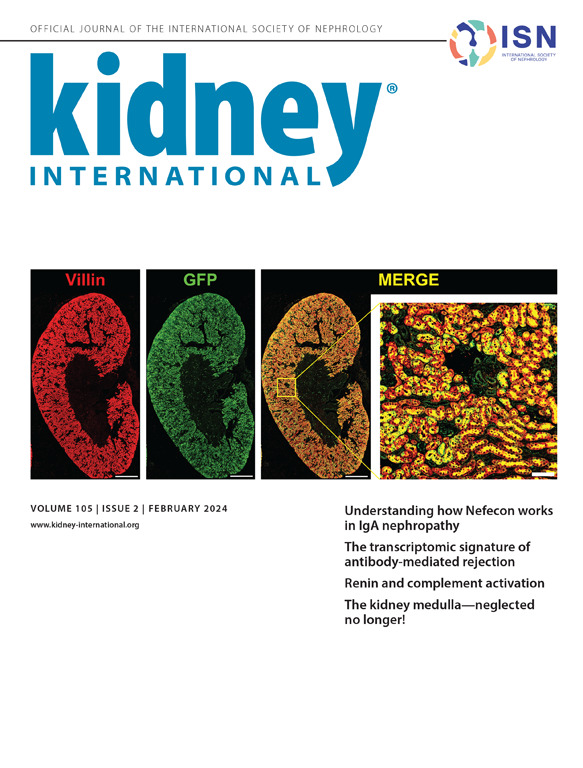Single-cell analysis of proximal tubular cells with different DNA content reveals functional heterogeneity in the acute kidney injury to chronic kidney disease transition.
IF 14.8
1区 医学
Q1 UROLOGY & NEPHROLOGY
引用次数: 0
Abstract
INTRODUCTION Proximal tubular epithelial cells with different DNA contents emerge after acute kidney injury (AKI). However, their heterogeneity and roles in the acute kidney injury-to-chronic kidney disease (AKI-to-CKD) transition remain incompletely understood. METHODS Proximal tubular epithelial cells with different DNA contents were isolated at days 3 and 14 post-AKI following ischemia reperfusion injury for single-cell RNA sequencing. RESULTS Here, we found that proximal tubular epithelial cells with different DNA contents have existing and distinct bulk transcriptome profiles, especially those cells over 4N (polyploid cells with more than four chromosome sets) with upregulated profibrotic signatures. Heterogeneity existed within four distinct functional clusters. In particular, the polyploid cells demonstrated a preferential enrichment within specific proinflammatory and profibrotic clusters post-AKI. Polyploid cells within these specific clusters displayed the profibrotic trajectory, accompanied by increased fibrosis-driving regulon activity and very strong cell-cell interactions. This suggests polyploidy cells have an intrinsic role in promoting the AKI-to-CKD transition. Furthermore, we identified that secreted phosphoprotein 1 (SPP1) as the pivotal hub of polyploid cells and may be involved in various profibrotic signaling pathways. Genetic knockdown of SPP1 in the proximal tubule in vivo dramatically ameliorated kidney fibrosis. CONCLUSIONS Overall, our findings reveal the heterogeneity of proximal tubular epithelial cells with different DNA contents and identify intrinsic factors of polyploid cells such as SPP1 expression in promoting kidney fibrosis. Our study provides novel insights into potential therapeutic target of preventing the AKI-to-CKD transition.不同DNA含量的近端肾小管细胞单细胞分析揭示了急性肾损伤向慢性肾脏疾病过渡过程中的功能异质性。
急性肾损伤(AKI)后出现不同DNA含量的近端肾小管上皮细胞。然而,它们在急性肾损伤到慢性肾病(aki到ckd)转变中的异质性和作用仍未完全了解。方法分别于缺血再灌注损伤后第3天和第14天分离不同DNA含量的近端小管上皮细胞,进行单细胞RNA测序。结果,我们发现不同DNA含量的近端小管上皮细胞具有不同的转录组谱,特别是那些超过4N的细胞(具有超过4组染色体的多倍体细胞)具有上调的纤维化特征。异质性存在于四个不同的功能集群中。特别是,在aki后,多倍体细胞在特定的促炎和促纤维化簇中表现出优先富集。这些特定簇内的多倍体细胞表现出纤维化的轨迹,伴随着纤维化驱动调控活性的增加和非常强的细胞间相互作用。这表明多倍体细胞在促进aki向ckd转变中具有内在作用。此外,我们发现分泌磷酸化蛋白1 (SPP1)是多倍体细胞的枢纽,可能参与多种纤维化信号通路。体内近端小管SPP1基因敲低可显著改善肾纤维化。总之,我们的研究结果揭示了不同DNA含量的近端小管上皮细胞的异质性,并确定了多倍体细胞的内在因素,如SPP1的表达在促进肾纤维化中的作用。我们的研究为预防aki向ckd转变的潜在治疗靶点提供了新的见解。
本文章由计算机程序翻译,如有差异,请以英文原文为准。
求助全文
约1分钟内获得全文
求助全文
来源期刊

Kidney international
医学-泌尿学与肾脏学
CiteScore
23.30
自引率
3.10%
发文量
490
审稿时长
3-6 weeks
期刊介绍:
Kidney International (KI), the official journal of the International Society of Nephrology, is led by Dr. Pierre Ronco (Paris, France) and stands as one of nephrology's most cited and esteemed publications worldwide.
KI provides exceptional benefits for both readers and authors, featuring highly cited original articles, focused reviews, cutting-edge imaging techniques, and lively discussions on controversial topics.
The journal is dedicated to kidney research, serving researchers, clinical investigators, and practicing nephrologists.
 求助内容:
求助内容: 应助结果提醒方式:
应助结果提醒方式:


